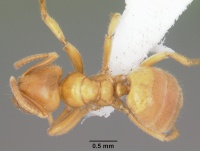Acropyga bakwele
| Acropyga bakwele | |
|---|---|

| |
| Scientific classification | |
| Kingdom: | Animalia |
| Phylum: | Arthropoda |
| Class: | Insecta |
| Order: | Hymenoptera |
| Family: | Formicidae |
| Subfamily: | Formicinae |
| Tribe: | Plagiolepidini |
| Genus: | Acropyga |
| Species: | A. bakwele |
| Binomial name | |
| Acropyga bakwele LaPolla & Fisher, 2005 | |
Only known from the type material, collected from leaf litter in rainforest.
Identification
LaPolla and Fisher (2005) - 8-toothed mandible; mandibular apical tooth about twice as along as other teeth; median ocellus present; total length > 3 mm.
Keys including this Species
Distribution
Latitudinal Distribution Pattern
Latitudinal Range: 2.08° to 2.068888889°.
| North Temperate |
North Subtropical |
Tropical | South Subtropical |
South Temperate |
- Source: AntMaps
Distribution based on Regional Taxon Lists
Afrotropical Region: Gabon (type locality).
Distribution based on AntMaps
Distribution based on AntWeb specimens
Check data from AntWeb
Countries Occupied
| Number of countries occupied by this species based on AntWiki Regional Taxon Lists. In general, fewer countries occupied indicates a narrower range, while more countries indicates a more widespread species. |

|
Estimated Abundance
| Relative abundance based on number of AntMaps records per species (this species within the purple bar). Fewer records (to the left) indicates a less abundant/encountered species while more records (to the right) indicates more abundant/encountered species. |

|
Biology
|
Castes
Queens and Males of the species are unknown.
Worker
Images from AntWeb

| |
| Holotype of Acropyga bakwele. Worker. Specimen code casent0104123. Photographer April Nobile, uploaded by California Academy of Sciences. | Owned by CAS, San Francisco, CA, USA. |
Nomenclature
The following information is derived from Barry Bolton's Online Catalogue of the Ants of the World.
- bakwele. Acropyga bakwele LaPolla & Fisher, 2005: 602, figs. 1-4 (w.) GABON.
Unless otherwise noted the text for the remainder of this section is reported from the publication that includes the original description.
Description
Worker
(Holotype worker) TL: 3.24; HL: 0.902; HW: 0.870; SL: 0.751; ML:1.069; GL: 1.272; CI: 96.45; SI: 86.32.
Overall appearance similar to Acropyga arnoldi and Acropyga silvestrii, see LaPolla (2004) for details of these two species. Head: reddish-yellow; head slightly longer than wide; covered in a thick layer of appressed hairs, with short erect hairs along posterior margin; posterior margin slightly concave medially; median ocellus present; eyes relatively large for an Acropyga (ca. 10 facets) and placed at lower ¼ of head; 11-segmented, incrassate antennae; scape surpasses posterior margin by about half length of pedicel; scape with thick layer of appressed hairs, scattered erect hairs throughout; clypeus slightly convex medially; mandible broad, with six distinct teeth; mandibular basal angle distinct, but not forming seventh tooth; apical tooth twice as long as other teeth. Mesosoma: reddish-yellow; in lateral view, pronotum with short anterior shelf; dorsum covered in layer of appressed hairs, with scattered erect to suberect hairs throughout; metanotal area distinct; propodeum rounded; declivity steep. Gaster: petiole think and erect, with erect hairs; gaster reddish-yellow, with thick layer of appressed hairs and scattered erect to suberect hairs throughout.
Etymology
The species epithet, bakwele, is in honor of the Bakwele pygmies who assisted BLF during his fieldwork in Gabon.
References
LaPolla, J.S. and Fisher, B.L. 2005. A remarkable new species of Acropyga from Gabon, with a key to the Afrotropical species. Proceedings of the California Academy of Sciences. 56(4):601-605. (page 602, figs. 1-4 worker described)

